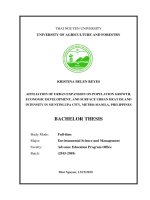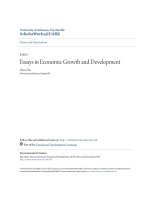Economic growth and economic development 349
Bạn đang xem bản rút gọn của tài liệu. Xem và tải ngay bản đầy đủ của tài liệu tại đây (144.01 KB, 1 trang )
Introduction to Modern Economic Growth
is a piecewise continuous function implies that the optimal control may include discontinuities, but these will be relatively “rare”–in particular, it will be continuous
“most of the time”. More important, the added generality of allowing discontinuities
is somewhat superfluous in most economic applications, because economic problems
often have enough structure to ensure that yˆ (t) is indeed a continuous function of
time. Consequently, in most economic problems (and in all of the models studied
in this book) it will be sufficient to focus on the necessary conditions (7.34)-(7.36).
It is also useful to have a different version of the necessary conditions in Theorem
7.9, which are directly comparable to the necessary conditions generated by dynamic
programming in the discrete time dynamic optimization problems studied in the
previous chapter. In particular, the necessary conditions can also be expressed in
the form of the so-called Hamilton-Jacobi-Bellman (HJB) equation.
Theorem 7.10. (Hamilton-Jacobi-Bellman Equations) Let V (t, x) be as
defined in (7.31) and suppose that the hypotheses in Theorem 7.9 hold. Then whenever V (t, x) is differentiable in (t, x), the optimal pair (ˆ
x (t) , yˆ (t)) satisfies the HJB
equation:
(7.37)
f (t, xˆ (t) , yˆ (t)) +
∂V (t, xˆ (t)) ∂V (t, xˆ (t))
+
g (t, xˆ (t) , yˆ (t)) = 0 for all t ∈ R.
∂t
∂x
Proof. From Lemma 7.1, we have that for the optimal pair (ˆ
x (t) , yˆ (t)),
Z t
f (s, xˆ (s) , yˆ (s)) ds + V (t, xˆ (t)) for all t.
V (t0 , x0 ) =
t0
Differentiating this with respect to t and using the differentiability of V and Leibniz’s
rule, we obtain
∂V (t, xˆ (t)) ∂V (t, xˆ (t))
+
x˙ (t) = 0 for all t.
∂t
∂x
Setting x˙ (t) = g (t, xˆ (t) , yˆ (t)) gives (7.37).
f (t, xˆ (t) , yˆ (t)) +
Ô
The HJB equation will be useful in providing an intuition for the Maximum
Principle, in the proof of Theorem 7.9 and also in many of the endogenous technology
models studied below. For now it suffices to note a few important features. First,
given that the continuous differentiability of f and g, the assumption that V (t, x)
is differentiable is not very restrictive, since the optimal control yˆ (t) is piecewise
335









